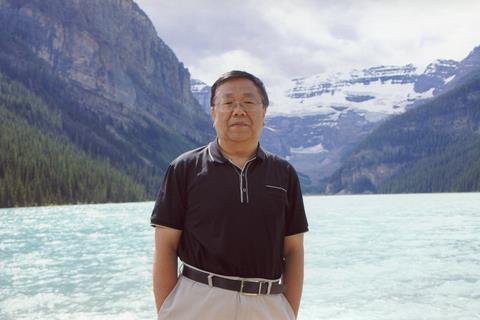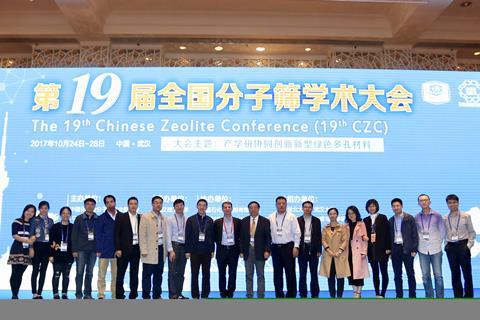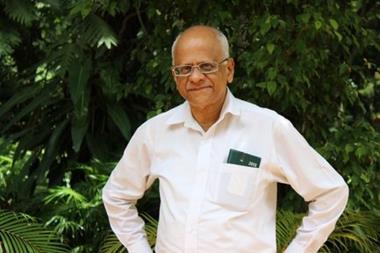Shilun Qiu was a farmer before he became a chemist. Now he’s a distinguished professor at Jilin University’s state key laboratory of inorganic synthesis and preparative chemistry in China. Clare Sansom caught up with him at the 24th Congress of the International Union of Crystallography in Hyderabad this August
Life must have been very difficult for ambitious, scientifically-minded teenagers growing up in the People’s Republic of China in the 1960s. Shilun Qiu, now one of China’s most respected inorganic chemists, was one of these. In 1966, when he left school, the Cultural Revolution was just starting. All Chinese universities had to stop taking undergraduate students and Qiu, like many of his contemporaries, was given no option: he had to go into the fields to farm. He spent a total of 11 years outside science, first as a farmer and then as a manual worker, and was only able to start studying chemistry in 1977, after the big changes in Chinese society introduced by Deng Xiaoping. ‘I was almost 30 when I began my undergraduate studies at Jilin University,’ he says. ‘But I eventually caught up with my contemporaries in developed countries; I was appointed a full professor in 1994.’
The China in which Qiu studied for his degrees, however, was still a very long way from the powerhouse of science and technology that we know today. The lack of opportunities available influenced his choice of PhD subject. ‘I wanted to specialise in inorganic chemistry, and approached Wenqin Pang, who studied zeolites and was one of a few inorganic chemists at Jilin that time,’ Qiu says. That choice – or perhaps lack of choice – proved inspired. They worked in close collaboration with Ruren Xu, who was already highly respected in the porous materials field and introduced them to state-of-the-art techniques and world-class experts. ‘Xu was also a very good supervisor,’ remembers Qiu.
The name ‘zeolite’ is given to any natural or synthetic microporous aluminosilicate mineral; their pores can hold a variety of metal cations and their high surface area makes them effective adsorbents and catalysts. It takes billions of years to produce a natural zeolite from alumina and silica, and several methods exist for replicating this many orders of magnitude more rapidly to form artificial ones. Now Qiu and his group can produce zeolites in a few hours using ultra reactive systems. ‘We can synthesise zeolites with diverse structures and properties, and they are stable and cheap to make,’ he says. ‘They have many industrial uses, for example as catalysts for cracking extracted oil to form gasoline, diesel and many other valuable products.’
Sea change

After Qiu finished his PhD in the mid-1980s, Xu encouraged him to take up a postdoctoral fellowship at the University of Upper Alsace in France, in a laboratory that was considered one of the best in the world for studying porous materials. He was something of a pioneer there, as at that time few Chinese postdocs ventured abroad. Now, in contrast, almost all Chinese PhD students are encouraged to go abroad for their postdocs: to Europe, the US and sometimes Japan. ‘We therefore have to find our own postdocs in other countries; most of my recent ones have come from India and Pakistan,’ he adds.
Qiu maintains some research interests in zeolite chemistry, but the main focus of his work has now switched to new families of porous materials: metal–organic frameworks (MOFs) and the related covalent organic frameworks (COFs), which are similar to MOFs but lack the bound metal ions. ‘Compared to zeolites, MOFs (and COFs) are more expensive to synthesise and less stable, but they are more complex and versatile, and it is easier to design frameworks with specific properties,’ he explains. His group designs and synthesises porous materials, using molecular engineering and if the materials are crystalline, crystal engineering.
In 2009, Qiu published the synthesis of a novel porous material they called porous aromatic framework 1 (PAF-1).1 It has a diamond-like lattice structure in which the carbon–carbon bonds of diamond are replaced by phenyl rings. ‘When we published this paper, PAF-1 had the highest internal surface area of any material known, although it has now been superseded by a new MOF,’ he says. More importantly, these aromatic frameworks are exceptionally stable and can be used for catalysis, molecular separations, selective adsorption or as sensors. ‘It is also possible to remove the hydrogen from these frameworks, leaving porous forms of carbon that are very useful materials for batteries,’ he adds.

During his long career, Qiu has actively contributed to raising the profile of science in his country and is happy to see that China has now become a scientific super-power. Of course, there are still problems to be addressed, but the funding is improving and, crucially, talented Chinese and foreign scientists based overseas are being attracted to China. Several prominent scientists in Qiu’s group have benefited from the ‘Thousand Talents Program’ which provides generous support for independent scientists willing to work in China for the long term. Qiu himself will retire from his university position next year but, he says, “Retired professors in China are allowed to continue with their research, and I intend to take advantage of this.”
References
1 T Ben et al, Angewandte Chemie International Edition, 2009, 48, 9457 (DOI: 10.1002/anie.200904637)















No comments yet